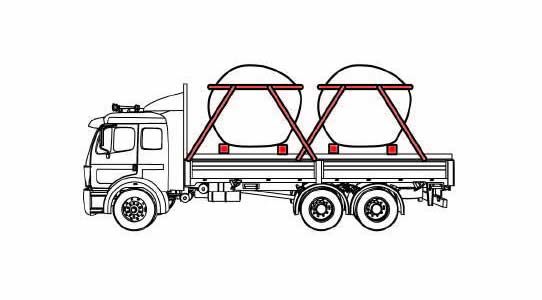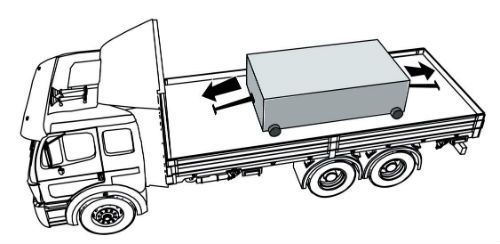CDL Practice Tests: Flatbed Cargo Securement
Choose A Section:
Go!What is the maximum weight that can be secured by a tiedown with a marked WLL of 5,000 lbs?
- 2,500 lbs
- 5,000 lbs
- 10,000 lbs
- 6,000 lbs
Note: The minimum WLL requirement for the securement system is 50%. More tiedown capacity should be used if you need to secure an article against any movement.
When securing a non-cubic boulder with an unstable base, the four surrounding chains must have a WLL of at least:
- 5,000 lbs
- 25% the weight of the boulder
- 50% the weight of the boulder
- 11,000 lbs
Special Circumstances: Securing a Non-Cubic Shaped Boulder with an Unstable Base
The securement of a non-cubic shaped boulder with an unstable base must meet these requirements in addition to the other large boulder requirements in Section 13.

Surround the top of each boulder at a point between 1/2 and 2/3 of its height with one chain.
The WLL of the chain must be at least 50% of the weight of the boulder.
Attach four chains to the surrounding chain and the vehicle to form a blocking mechanism that prevents any horizontal movement.
Each chain must have a WLL of at least 25% the weight of the boulder, and the angle of the chain must be less than 45° from the horizontal.
When securing metal coils in a sided vehicle without anchor points:
- All of these apply
- Use locking and bracing
- Follow general cargo securement requirements
- Use friction mats
Securing Coils Transported in a Sided Vehicle or Intermodal Container without Anchor Points
To prevent metal coils from moving horizontally and/or tipping:
Follow general cargo securement requirements
Secure the coils using:
- Blocking and bracing
- Friction mats
- A combination of these.
When loading paper rolls with eyes horizontal, which of the following is not a requirement for stacking a second layer:
- The bottom layer must extend all the way to the front.
- Place second layer with eyes vertical.
- It must be blocked against an eye-vertical blocking roll resting on the floor of the vehicle that is at least 1.5 times taller than the diameter of the roll being blocked.
- All the wells in the layer beneath must be filled
Requirements for eyes crosswise: secure stacks of paper rolls from front-to-back movement
- Do not load paper rolls on a second layer unless the bottom layer extends to the front of the vehicle.
- Load paper rolls on higher layers only if all wells in the layer beneath are filled.
-
Secure the foremost roll in each upper layer (or any roll with an empty well in front of it) against forward movement:
- Either by placing it in a well formed by two rolls on the lower row whose diameter is equal to or greater than that of the roll on the upper row.
- Or by banding it to other rolls.
- Or by blocking it against an eye-vertical blocking roll resting on the floor of the vehicle that is at least 1.5 times taller than the diameter of the roll being blocked.
If you were instructed to 'tarp' a load, what would you be using?
- A platform or tray on which cargo is placed so that it can be handled as an article.
- A strip of material that may be used to unitize articles and is tensioned and clamped or crimped back upon itself.
- A waterproof sheet used to cover cargo.
- A short piece of material, usually wood, nailed to the deck to reinforce blocking.
Tarp:
A waterproof sheet used to cover cargo.
When securing flattened or crushed cars on a vehicle with containment on 2 sides, how many tiedowns, at minimum, are required?
- 1
- 3
- 4
- 2
Option 3:
Has containment walls on two sides that:
- Extend to the full height of the load.
- Block against cargo movement in the forward and rearward.
Secures each stack of vehicles with a minimum of three tiedowns, each having a minimum WLL of 2,268 kg (5,000 lb.).
When securing building materials, how many tiedowns are required for top tier bundles longer than 5 ft?
- 2
- 1
- It depends on weight
- 0
Tiedowns over the top tier of bundles with a minimum of 2 tiedowns over each top bundle longer than 1.52 m (5 ft).
Aggregate Working Load Limit is defined as:
- The summation of the working load limits or restraining capacity of all devices used to secure an article on a vehicle.
- The maximum weight of a load of rocks that a securement device can withstand.
- A combination of securing devices which form an assembly that attaches cargo to, or restrains cargo on, a vehicle or trailer, and is attached to anchor point(s).
- The maximum load that may be applied to a component of a cargo securement system during normal service, usually assigned by the manufacturer of the component.
Aggregate Working Load Limit:
The summation of the working load limits or restraining capacity of all devices used to secure an article on a vehicle.
A bulkhead is defined as:
- A vertical barrier placed directly behind the cab of a tractor to protect the cab in the event cargo should shift forward.
- A vertical barrier across a vehicle to prevent forward movement of cargo.
- A structure, device, or another substantial article placed against or around an article to prevent horizontal movement of the article.
- A vertical barrier across the front of the deck of a vehicle to prevent forward movement of cargo.
Bulkhead:
A vertical barrier across a vehicle to prevent forward movement of cargo.
What is the minimum WLL of each tiedown used to secure crushed or flattened vehicles?
- It depends on the vehicle
- 5,000 lbs
- 10,000 lbs
- 2,268 lbs
Option 2:
Has containment walls on three sides that:
- Extend to the full height of the load
- Block against cargo movement in the forward, rearward, and one sideways direction.
Secures each stack of vehicles with a minimum of two tiedowns, each having a minimum WLL of 2,268 kg (5,000 lb.).
Option 3:
Has containment walls on two sides that:
- Extend to the full height of the load.
- Block against cargo movement in the forward and rearward.
Secures each stack of vehicles with a minimum of three tiedowns, each having a minimum WLL of 2,268 kg (5,000 lb.).
Option 4:
Has a minimum of four tiedowns per vehicle stack with each tiedown having a minimum WLL of 2,268 kg (5,000 lb.).
About The Flatbed Cargo Securement CDL Manual
Studying the flatbed cargo securement CDL manual is not a requirement for getting your CDL permit or license. It is required knowledge for flatbed drivers.
Some questions you should be able to answer for flatbed cargo securement:
- What is the minimum Working Load Limit of a tiedown used to secure logs?
- What is the minimum weight of a shipment of paper rolls that would require specific securement requirements?
- When securing concrete pipe over 45 inches loaded crosswise, which direction must the tiedowns on the front half of the load run?
- What is a cab shield?
- When securing concrete pipe over 45 inches loaded crosswise, which direction must the tiedowns on the rear half of the load run?
- What is a dunnage bag?
- Who is responsible for inspecting securing devices and cargo within the first 50 miles?
- How many tiedowns are required on a stack of shortwood loaded crosswise?
- What is the minimum working load limit of each tiedown used to secure crushed or flattened vehicles?
- Define 'bolster'
- What is a hook-lift container?
- When a tiedown is attached directly to the cargo, what is the ideal angle where it attached to the vehicle?
What is a securing device?
Any device specifically manufactured to attach or secure cargo to a vehicle or trailer:
- Synthetic Webbing
- Chain
- Wire rope
- Manila rope
- Synthetic rope
- Steel strapping
- Clamps and latches
- Blocking
- Front-end structure
- Grab hooks
- Binders
- Shackles
- Winches
- Stake pockets
- D-rings
- Webbing ratchet
- Bracing
- Friction mat
What is a tiedown?
A combination of securing devices that forms an assembly that:
- Attaches cargo to, or restrains cargo on a vehicle.
- Is attached to anchor point(s).

Some tiedowns are attached to the cargo and provide direct resistance to restrain the cargo from movement.

Some tie-downs pass over or through the cargo. They create a downward force that increases the effect of friction between the cargo and the deck. This friction restrains the cargo.
 Related Cargo Securement Terms That Every Driver Should Know:
Related Cargo Securement Terms That Every Driver Should Know:
-
Tiedown:
A combination of securing devices which form an assembly that attaches cargo to, or restrains cargo on, a vehicle or trailer, and is attached to anchor point(s).
-
Contained:
Cargo is contained if it fills a sided vehicle, and every article is in contact with or sufficiently close to a wall or other articles so that it cannot shift or tip if those other articles are also unable to shift or tip.
-
Blocking:
A structure, device, or another substantial article placed against or around an article to prevent horizontal movement of the article.
How should tiedowns be attached?
Tiedowns can be used in two ways:
-
Attached to the cargo:
- Tiedowns attached to the vehicle and attached to the cargo.
- Tiedowns attached to the vehicle, pass through or aroundan article of cargo, and then are attached to the vehicle again.
-
Pass over the cargo:
- Tiedowns attached to the vehicle, passed over the cargo, and then attached to the vehicle again.
Tiedown placement:

Place the tiedown as close as possible to the spacer.
Position the tiedowns as symetrically as possible over the length of the article.

Position the tiedowns to preserve the integrity of the article.







 TT On Facebook
TT On Facebook